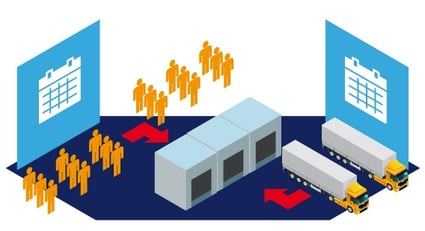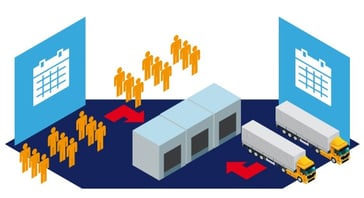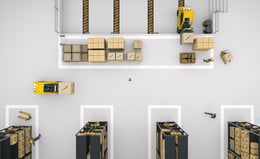Match Game: Choosing the Right Container for the Right Parts
Brian Hoey - September 18, 2018

 Let’s say you’re moving into a new home. After a long day of loading boxes and furniture into your car and driving them to your new place of residence you’ve finally transported everything into your new house and you’re almost ready to start unpacking and get the place settled. Before you get down to the work of opening up all of your packed boxes, you realize that you haven’t eaten all day, and should probably whip something up before you do any more manual labor. It should be pretty easy to find your kitchen supplies and snack foods, because you made a list of what was in each box before you moved them. One problem: you don’t know which box the list is in.
Let’s say you’re moving into a new home. After a long day of loading boxes and furniture into your car and driving them to your new place of residence you’ve finally transported everything into your new house and you’re almost ready to start unpacking and get the place settled. Before you get down to the work of opening up all of your packed boxes, you realize that you haven’t eaten all day, and should probably whip something up before you do any more manual labor. It should be pretty easy to find your kitchen supplies and snack foods, because you made a list of what was in each box before you moved them. One problem: you don’t know which box the list is in.
Most likely the only issue you’re going to have to grapple with as you search for your master container list is low blood sugar—but what if those boxes didn’t contain home goods, but parts necessary for ongoing production plans? In an industrial context, say an automotive manufacturing warehouse, the stakes for this type of low visibility can be much higher. As such, businesses need to take control of their container management to ensure that they don’t find themselves in a predicament like the one above.
Container Transparency
Not to put too fine a point on it, but the issue faced in the unpacking scenario is fundamentally one of transparency. You have a large quantity of containers, and you don’t know what’s in them. Unfortunately, this is an all too common state of affairs in the modern supply chain, and it can lead to huge bottlenecks and slowdowns when production processes are unable to access necessary parts, either because they can’t be unloaded efficiently or because they’re not there at all.
Imagine that you’re a production planner, and you’ve just received a larger order than your demand forecasts prepared you for. Without a highly visible, centralized control tower that tracks your container usage and gives you real-time insight into your inventory levels, you would be at a loss to determine whether or not you had the necessary component parts on hand to increase your production capacity to meet this new level of demand. Many inventory planners use past demand as one of their most heavily weighted criteria when choosing what levels of what parts to stock in their warehouse, and as a result they often lack the flexibility to respond to evolving demand conditions. Production programs may change even while parts in transit, and without a solution that connects the containers in your yard to your planning workflows you risk bottlenecks in your production facilities.
Load and Unload
We’ve seen above how the first hurdle to overcome in effective container management is creating the visibility and transparency necessary to make optimal container usage a cornerstone of lean, dynamic supply chain management. But once you have an accurate snapshot of this particular touchpoint on your company’s value chain, how do you leverage that visibility into even more value? One tactic is to develop a more optimized load/unload strategy that accounts for probable changes in demand and future production schemes. Ideally, your centralized container management system allows you to analyze existing inventory in order to determine how many days or how many products or layers of production your existing stock can sustain, shifting those estimates as you adjust your production parameters. From there, manufacturers can reconfigure that data into a series of sequential steps that accounts for the pull of any given production workflow (i.e. a certain number of one part demands a specific ratio of another), and can then take steps to load their parts into containers in such a way that will create synergy between unloading and the production schedules that unloading supports.
If your factory is producing automobiles, for instance, an optimal container management strategy would enable you to load parts in such a way that you could pull materials in a timely manner based on your production sequences. This might result in a given container storing the parts for a certain number of cars in sequence, rather than each container storing only a specific part. While in a low-visibility environment this could add unwanted complexity, planners who are able to track their inventory levels and optimize their loads with sophisticated 3d interfaces can gain significant value from the added efficiency.
Reducing Overhead
Now, all of these increases in efficiency are certainly nice—but are they the be-all-end-all of container management? On the contrary, they are just constitutive parts of the more holistic way in which more efficient container loading and unloading coupled with bolstered visibility can add value. Taken as a whole, these factors combine not just to smooth out production workflows, but also to use space in a more efficient way, leading to reduced inventory needs and lowered overhead costs. By optimizing space allocation, planners can eliminate dead or underutilized container space, and ultimately fit more parts into fewer containers. Combined with the optimization tactics we discussed above in which parts are grouped together based on production sequencing (and other factors like expiration date, potential for damage, etc.), your container management has the potential to be a key building block of a leaner supply chain with shortened lead times and greater flexibility.
LATEST POSTS
- Understand Circular Economy in The Manufacturing Industry
- How Can Industry 4.0 IT Integration Be Achieved Smoothly?
- The Significance of Order Sequencing in Discrete Manufacturing
- How to improve your Supply Chain Management: The Power of Control Towers
- Optimizing Human Resource Scheduling in Manufacturing: A Technological Approach



